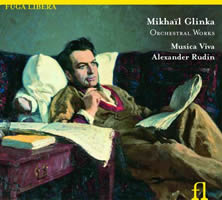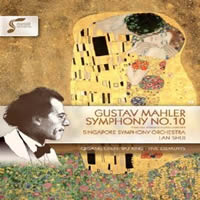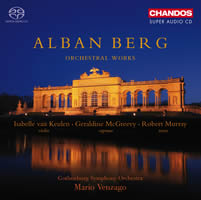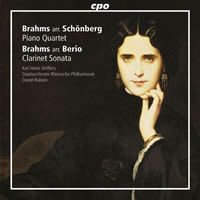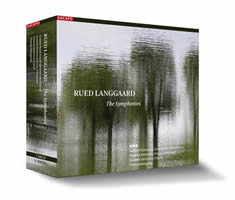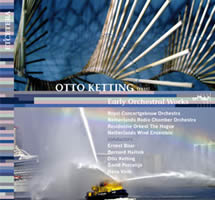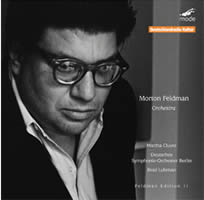Mostly Symphonies 20.
|
Grant Chu Covell [September 2012.]
Mikhail GLINKA: Overture in D major (1822); Overture in G minor (1822); Romance: “Do Not Call Her Heavenly” (1834, orch. 1855)1; Symphony in B-flat major (1822-26; compl. Petr Klimov); Romance: “Cradle Song” (1840)2; Three Dances from A Life for the Tsar (1834, ed. P. Klimov)4; Romance: “The Midnight Review” (1834, orch. 1855)3; Kamarinskaya (1848); Romance: “Soon You Will Forget Me” (1847, orch. 1955)1; Valse-fantaisie (1839, orch. 1845, rev. 1856). Olga Senderskaya (sop)1, Alina Shakirova (m-sop)2, Petr Novikov (bass)3, Ilya Konovalov (vln)4, Vitaly Nazarov (ob)4, Alexander Rudin (vlc)4, Musica Viva (Moscow Chamber Orchestra), Alexander Rudin (cond.). Fuga Libera FUG571 (1 CD) (http://www.fugalibera.com/). Exuberant performances propel charming, uncomplicated music. Look beyond the Ruslan and Lyudmila Overture and hear why later compatriots heralded Glinka as Russian music’s father. Perhaps the Romances with Russian texts are the least effective, despite their sweet docility. The G-minor Overture suggests Glinka couldn’t convey drama without dance. As a beautiful crystallization of Rossini and Mozart, the Overture in D major stands tall as does the delightful Kamarinskaya, the bittersweet melodies of which seem immediately familiar. The Valse-fantaisie and three dances from A Life for the Tsar prove that Glinka was a gifted animator. The Passo a tre and the Passo a due never made it into the final opera. Petr Klimov refreshed their orchestration and rounded out the youthful incomplete Symphony. A tune from Kamarinskaya stuck in my head for days.
Gustav MAHLER: Symphony No. 10 (1910; compl. Clinton CARPENTER, 1949, rev. 1966). Qigang CHEN: Wu Xing (“Five Elements”) (1999). Singapore Symphony Orchestra, Lan Shui (cond.). AVIE AV2222 (1 Blu-ray) (http://www.avie-records.com/). In all seriousness I suggest the central Purgatorio in its quasi-finished form is perhaps Mahler’s most perfect statement. The orchestra offers intimate chamber music with hairpin turns between innocence and irony, including, of course, a Wunderhorn tune. Others might disagree owing to the movement’s uncharacteristic brevity. Cooke’s completion has been my baseline for Mahler Tenths. It’s startling to hear extra voices, different notes and abundant Mahlerisch shenanigans. Carpenter’s excrescences come to the fore in the first scherzo. I recall reading that he rescored the completed Adagio’s climax, but could be wrong. Qigang Chen’s Wu Xing proudly waves the Tricolor. Having studied with Messiaen, his Five Elements echo a French sensibility extending to Debussy. These 13 minutes entrance with rosy polytonality. Fire’s major triads melt into light dissonance. Blu-rays are pretty to look at, but I earnestly tried to listen only. In the Mahler/Carpenter, crucial moments succumb to soft focus, as if a climax or decrescendo induces blurred vision — a technique not much better than dwelling on emoting musicians. Qigang Chen succumbs to distracting color schemes reflecting the music’s elements.
Alban BERG: Piano Sonata, Op. 1 (1908; arr. Theo VERBEY, 1984); Three Pieces, Op. 6 (1914-15; rev. 1929); Der Wein (1929) sung in French* and German**; Passacaglia (1913; arr. Christian von BORRIES, 1999); Concerto for Violin and Orchestra (1935)***; Three Fragments from Wozzeck (1923-24)**; Symphonic Pieces from the Opera Lulu (1934)**. Johann STRAUSS II: Wein, Weib und Gesang, Op. 333 (1869; arr. BERG, 1921). Geraldine McGreevy** (sop), Robert Murray* (ten), Isabelle van Keulen*** (vln), Gothenburg Symphony Orchestra, Mario Venzago (cond.). Chandos CHAN5074 (2 SACDs) (http://www.chandos.net/). I retain this set for the Verbey Op. 1 orchestration. Maybe I’ll try my hand at this some day. I think Verbey chooses wrong, starting with strings instead of winds and leaning towards a congested Lulu rather than staid Brahms. The standard works fail to produce chills or sweats, and the Gothenburgers should know better. The Three Pieces never terrify, and van Keulen’s restlessness doesn’t help the Violin Concerto. Details suffer: The soloist smudges the four-voice chorale, and poor balance obscures great orchestral moments such as the parallel fifth descending harp glissando which ought to slice like a razor. I’ll take Grumiaux’s recording any day. It’s nice to have the Wozzeck and Lulu pieces together, but I would trade the misguided Passacaglia orchestration, both Der Weins and Berg’s Strauss transcription for the Altenberg Lieder.
Johannes BRAHMS: Piano Quartet in G Minor, Op. 25 (1856-61; arr. Arnold SCHOENBERG, 1937-38); Sonata for Clarinet and Piano, Op. 120, No. 1 (1894; arr. Luciano BERIO, 1986)*. Karl-Heinz Steffens* (clar), Staatsorchester Rheinische Philharmonie, Daniel Raiskin (cond.). cpo 777 356-2 (1 CD) (http://www.cpo.de/). This disc handily unites Brahms’ Fifth and the Clarinet Concerto. Schoenberg’s flashier orchestration with bold brass and xylophone overwhelms Berio’s demure transcription. However, Berio correctly supports the clarinet with strings only. I prefer more smoldering and recklessness in the feisty Quartet and mahogany Sonata whether original or transcribed.
Rued LANGGAARD: The Symphonies (16). Danish National Symphony Orchestra, Danish National Vocal Ensemble, Danish National Choir, Thomas Dausgaard (cond.). Dacapo 6.200001 (7 SACDs) (http://www.dacapo-records.dk/). Dacapo’s Langgaard symphonies rebundling makes for a pretty package. A specially designed box houses the seven discs and booklet. Individually released over a decade, the Danes and Dausgaard’s fine discs have been uniformly rebranded. Recalling multi-disc 78 sets, they sit in cardboard sleeves attached to the case. Pivoting the box lid nudges the discs forward. While getting at the booklet isn’t easy, the scant notes don’t warrant constant reference, as my only disappointment with the set. Langgaard’s 40-year symphonic breadth spanned 1911-51. With vivid orchestration and split-second contrast, he pushed and pulled Romantic music in every direction possible starting with Wagnerian gushing in No. 1. No. 2 added soprano, No. 3 includes a solo piano sounding like Grieg. Perhaps the 12th movement in the Fourth is Langgaard’s first onomatopoetic statement. There are two Fifths, the second shedding the overt Nielsen influences and revealing the first inkling that Langgaard’s universe is off-kilter. From a wandering string opening, the “Heaven-Rendering” Sixth’s resplendent tonality snags on atonal shifts. Chummy with Mendelssohn and channeling Schumann, No. 7 revisits the 19th century, though its transitions and piquant scherzo could only exist after 1900. Less than 20 minutes, the Eighth, “Memories at Amalienborg,” requires chorus and solo tenor and might be appropriate for summer bandstands. I had thought of Mary Poppins during the first movement and Sousa later on. Langgaard breezed through No. 9, generally a fraught milestone, with the anachronistic 1942 “From Queen Dagmar’s City” which embraces Schumann, Smetana and Glinka. Later symphonies similarly beguile. The 6:20 Eleventh, “Ixion,” features strange repetitions as if stuck in a groove. At 7:06, No. 12 isn’t much longer. The appropriately named Res Absurda!? sits on the last disc with Nos. 15 and 16 and some small tone poems. The 30-bar chorus-plus-orchestra work is meant for endless repetition and gradual acceleration. I did not count the loops. By 1948, an isolated Langgaard felt justifiably aggrieved.
“Early Orchestral Works.” Otto KETTING: Symphony No. 1 (1957-59)1; Due Canzoni per orchestra (1957)2; Concertino for two Trumpets and Orchestra (1958)3; Variazioni per orchestra (1960)4; Collage No. 9 for 22 Musicians (1963)5. Royal Concertgebouw Orchestra1, 5, Bernard Haitink1 (cond.), Ernest Bour5 (cond.), Residentie Orkest The Hague2, Hans Vonk2 (cond.), Arend van der Knaap3, Dick Teunissen3 (tpts), Netherlands Radio Chamber Orchestra3, Otto Ketting3 (cond.), Netherlands Wind Ensemble4, David Porcelijn4 (cond.). Etcetera KTC 1349 (1 CD) (http://www.etcetera-records.nl/). This thick slice of Ketting’s orchestral music overwhelms with multiple personalities. The single-movement First, two Canzoni and Concertino each appeared between 1957 and 1959, and demonstrate a love for Berg, Webern and neo-Classicism respectively. Ketting’s core becomes evident in the Variazioni which cements Berg with Stravinsky. Collage No. 9 represents avant-garde happenings: Bongos appear during the intermission amid audience noise as the musicians return to the stage.
“Orchestra.” Morton FELDMAN: Intersection 1 (1951, realization by Samuel Clay Birmaher); Structures (1960-62); On Time and the Instrumental Factor (1969); Voice and Instruments (1972)*; Orchestra (1976). Martha Cluver* (sop), Deutsches Symphonie-Orchester Berlin, Brad Lubman (cond.). Mode Records mode 238 (1 CD) (http://www.moderecords.com/). Difficult to believe that these are first recordings, though the graphic score Intersection 1 has seen life with a smaller lineup. Birmaher’s realization suggests Feldman’s development was an unbroken stream. The later, longer pieces behave differently, doing more with less. Perhaps it’s the Berliners’ seriousness, but Webern’s presence can be felt strongly throughout. On Time and the Instrumental Factor and Voice and Instruments offer slowly crossing and fading windmills, the voice in the latter cavorting like a toy duck amid large waves. Orchestra spreads menacingly, insisting upon a narrative unlike the others which seem content to offer interesting patterns.
[More Grant Chu Covell, Mostly Symphonies]
[Previous Article:
String Theory 9: 30 Quartets, etc.]
[Next Article:
Evolve or Perish]
|
